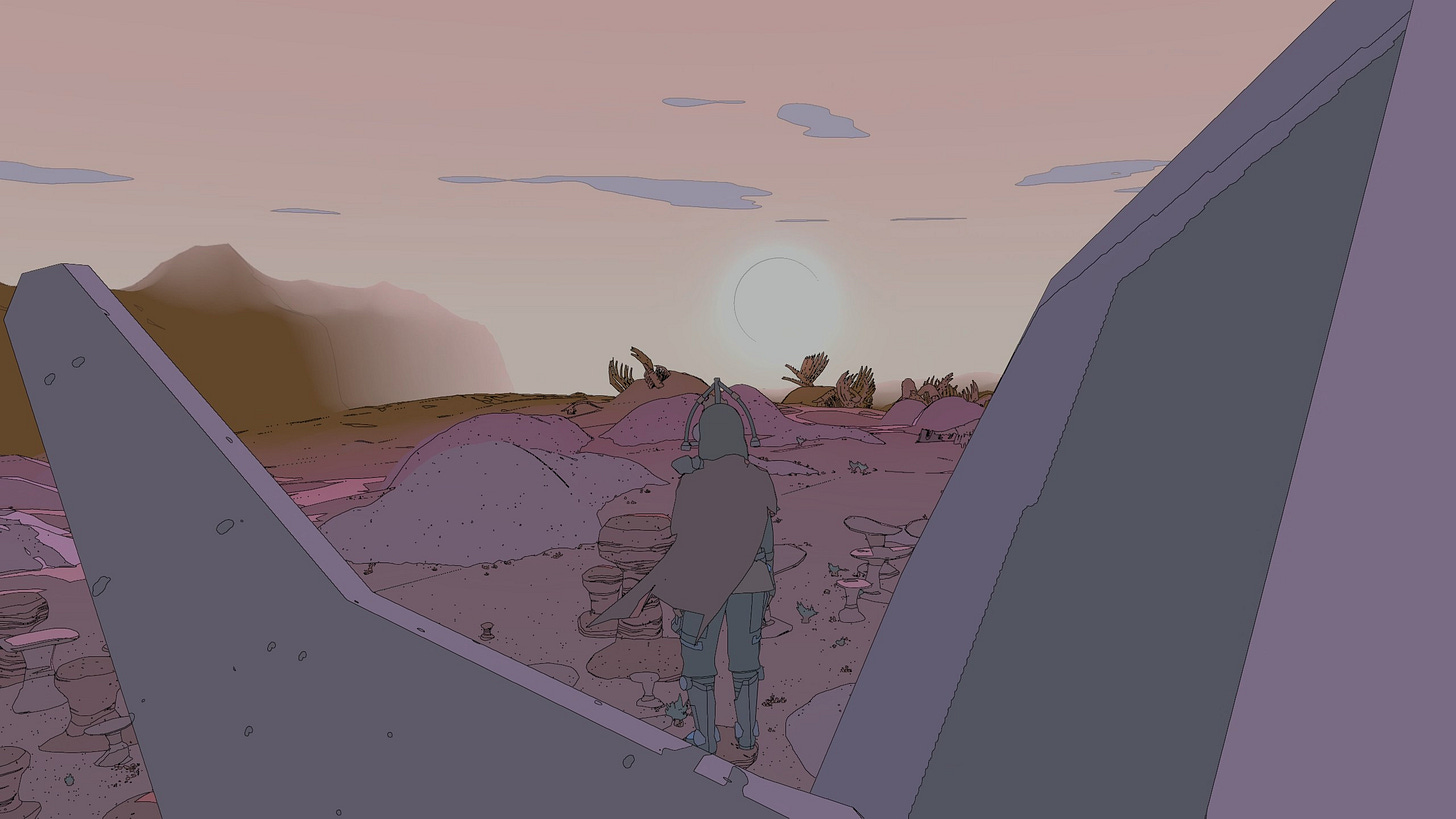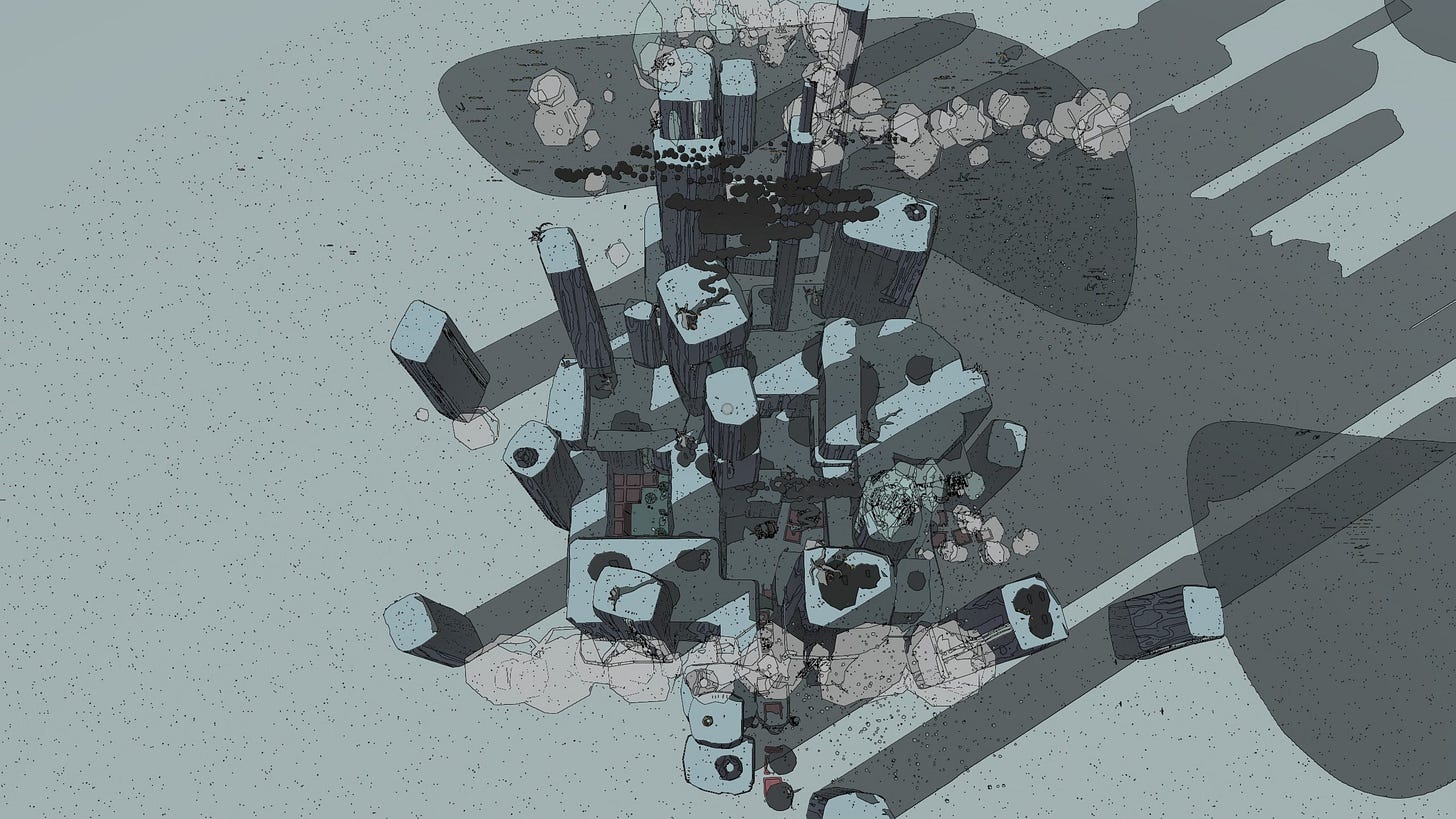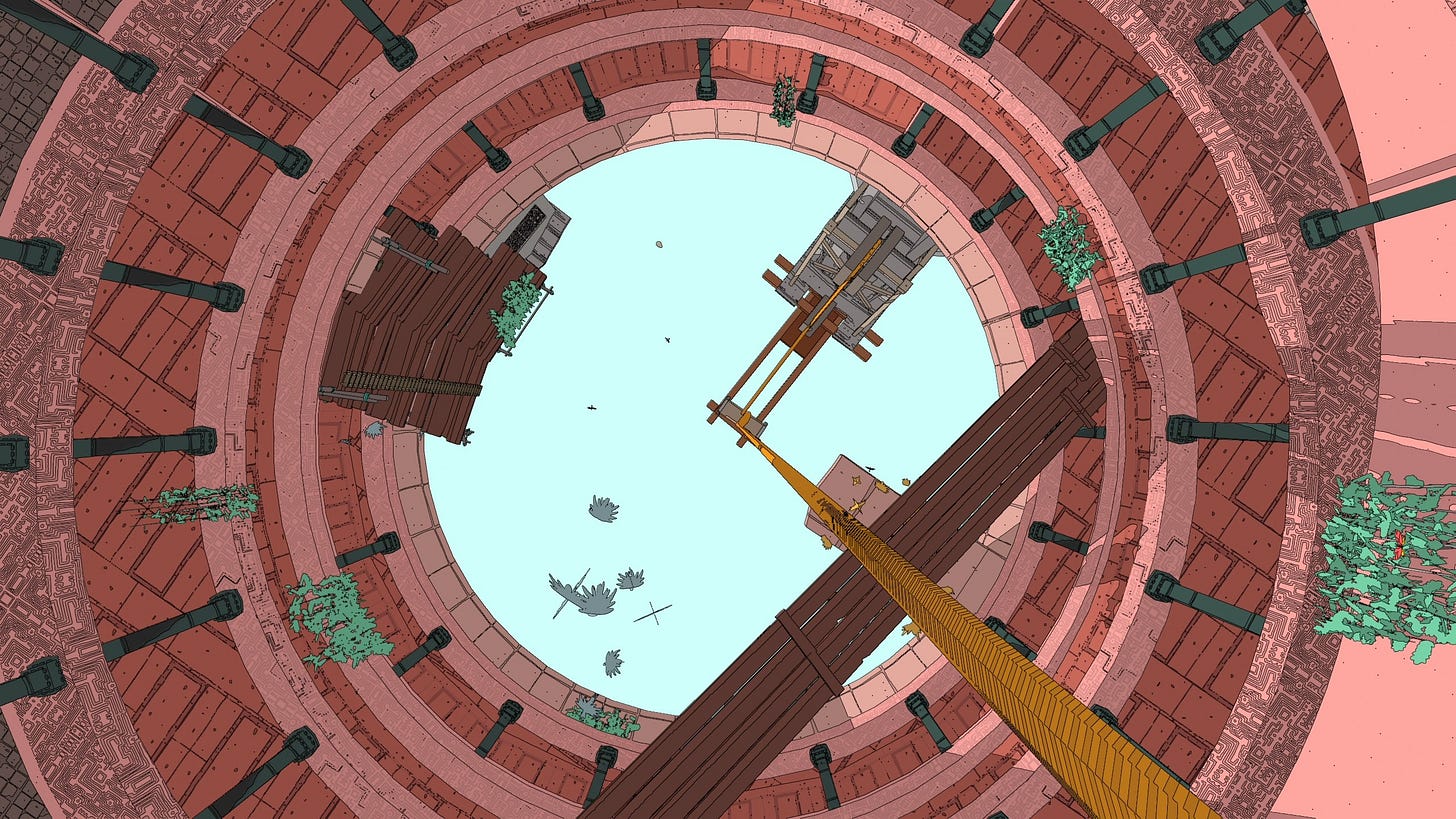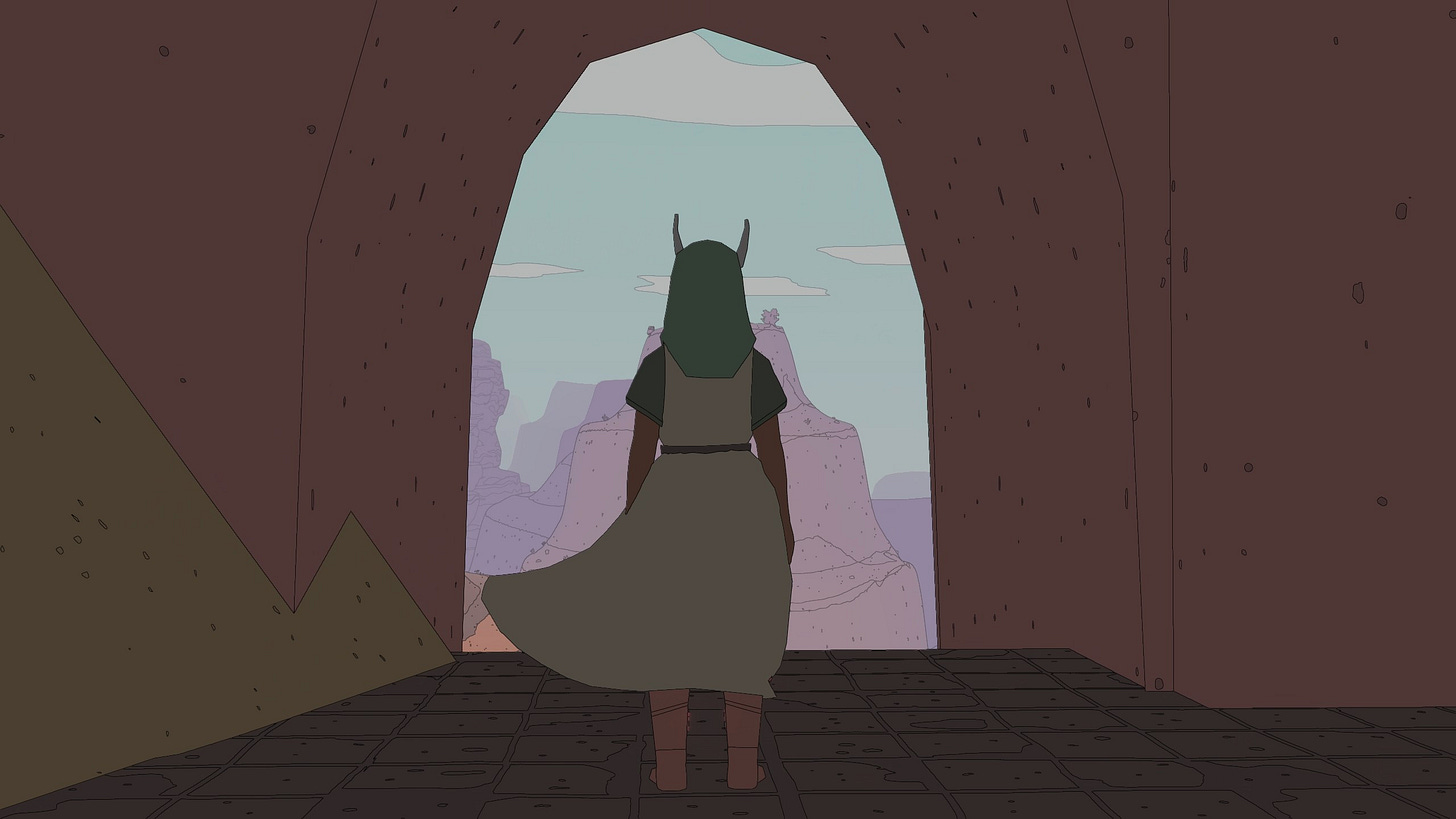Thoughts on Sable
An open world that doesn't require parrying!
Exploration and discovery are tricky things to do in a game, because both depend on the unknown. There’s a Venn diagram between authored intent and procedural generation which hits a sweet spot. Sable exists right in the middle.
I’ve had a vague theory about 3D being necessary for certain types of exploration. 2D games tend to have a tighter, more authorial style, where every pixel is carefully placed. When the third dimension is added it’s a multiplier of possibilities.
This was most apparent to me when playing Return of the Obra Dinn and Case of the Golden Idol back to back. Both are mystery games in which you play a detective, gathering clues and piecing together the correct order of events. The solving of mysteries involves combining verbs and names in a particular order. The games are very similar structurally, but Golden Idol is presented in classic 2D point-and-click fashion, while Obra Dinn is in 3D.
For me, Golden Idol felt more like I was hunting around the screen for clues and pixels left behind by the designers. Obra Dinn, with its 3D presentation, felt more like I was exploring a real space, with all the random possibilities within. This is an illusion, of course — they’re both as designed as each other, limited by the intentions of their cretaors. Three dimensional space, for detective games, adds an additional layer of puzzle which is navigation. There is no challenge in Golden Idol related to movement, whereas Obra Dinn combines observation with navigation to produce something fuzzier, despite their still only being a single ‘correct’ solution.
Outer Wilds is another good example. In theory there could be a 2D, point-and-click or platforming version of the game, with the story intact. But its strength lies in the mysteries of navigation as well as story. Simply getting from A to B is part of the investigation, as in Obra Dinn, and coming to an understanding of a space is as much of a joy as solving a puzzle. Golden Idol doesn’t have that: you flick through a handful of 2D screens and immediately understand the physical space, and all that is left is arranging the puzzle pieces.
To be clear, all of these games are excellent. I’m not saying that 3D is inherently better, as many of my favourite games are 2D. But I do think for exploration and discovery purposes, 3D brings a lot to the table.
Sable, then. That’s what I’m supposed to be writing about. This is Sable:
Sable is a game about space, and place. It’s architecture as exploration.
I went to a talk years ago — as in, probably two decades ago — with Alan Moore and Iain Sinclair, in which the latter talked about psychogeography. To quote from the Wikipedia page:
“…the study of the precise laws and specific effects of the geographical environment, consciously organized or not, on the emotions and behaviour of individuals." One of the key tactics for exploring psychogeography is the loosely defined urban walking practice known as the dérive. As a practice and theory, psychogeography has influenced a broad set of cultural actors, including artists, activists and academics.”
Clearly, my understanding of psychogeography doesn’t go much deeper than Wikipedia, but Sable reminded me of it. Even though it’s mostly rural, desert environments, rather than urban, it is full of its own history. The environment of the game reveals paths trodden and remnants of prior civilisation.
You’re not a stranger in a strange land, as in so many adventures and RPGs. This is your home, and always has been, but at the beginning of the game you go out into the world as an adult for the first time, exploring it by yourself and thereby seeing it anew.
It’s a layered game, told mostly through environmental details rather than direct exposition. There are quests, but they are generally lightweight and mostly excuses to visit interesting places.
Playing Sable feels like going on holiday, but a holiday in which you’re travelling and discovering a landscape, rather than sitting on a beach. The entire game hangs on the question of “I wonder what’s over that next dune?”
To get a bit more specific, this is perhaps best thought of as Breath of the Wild without any combat. There is no threat here, no need to learn how to do perfect parries. You run about in third person, hopping on your hoverbike to travel longer distances.
There’s a stamina wheel that counts down as you climb, turning traversal into mini-puzzles. You can increase your stamina, but even then the challenge is primarily in figuring out how to get from A to B. Considering it’s set in a series of deserts, the game manages to find ways to incorporate an impressive verticality.
The art style is very Moebius, very stripped back and stylised. Using the photo mode produces inevitably gorgeous images. Vistas are frequently breath-taking, as is the detail and sheer scale of the interiors. I’m avoiding spoilers here, because the game’s appeal is in how you stumble upon the world.
You can find new outfits, which are cosmetic and have no impact on what you can do (although cheeky descriptions note how clothing is better for hand-to-hand combat and similar — even though there is none). The bike designs are more versatile and do have a bigger impact on handling and speed, as well as being endlessly visually exciting.
It’s a delight to play a big, open world game that is a) not actually that big, b) can be played in under 10 hours and c) does not gate progress through combat.
I’ve got no problems with huge RPGs that have challenging combat. The Witcher 3 is probably my all-time favourite game. I recently loved Eternal Strands. But when every open world game requires a 100-hour commitment and the learning of an entirely new skillset, it can start to feel like homework. I haven’t bothered playing any Ubisoft games for over a decade, because they sound like too much work. Too big, too much random stuff on the to-do list.
Sable is the opposite of all of that, but without sacrificing the core appeal of a big, open world. It retains the exploration, but jettisons everything else, and it mostly pulls it off.
There is jank, which is perhaps inevitable for such a small team. The bikes are never as exciting to drive as it feels like they should be, and I inevitably went for the fastest bike and stuck with it, because I wanted to get about the place quickly. Bikes with better ‘handling’ didn’t seem to have a point, given that good handling is never really required.
Climbing is decent, but not as good as Breath of the Wild or Eternal Strands. It can feel awkward, and the camera frequently goes nuts and leaves you confused about where you are.
Quests are low-key, on purpose, but rarely give themselves the depth or time to dig into the characters. Combined with everyone wearing masks, and the personalities you encounter end up always feeling rather distant.
It’s a game primarily about place, for me. It’s people recede into the background, dwarfed by their surroundings. The landscape and its ruins are the main character, even before Sable herself. It sits in my memory as a place I visited, unique in all of gaming.








